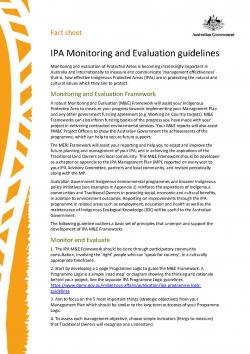IPA Monitoring and Evaluation guidelines - Fact sheet

IPA Monitoring and Evaluation guidelines to help measure and communicate the effectiveness of Indigenous land and sea management.
Monitoring and Evaluation of Protected Areas is becoming increasingly important in Australia and internationally to measure and communicate ‘management effectiveness’ - that is, how effective Indigenous Protected Areas (IPAs) are in protecting the natural and cultural values which they aim to protect.
Monitoring and Evaluation Framework
A robust Monitoring and Evaluation (M&E) Framework will assist your Indigenous Protected Area to measure your progress towards implementing your Management Plan and any other government funding agreement (e.g.. Working on Country targets). M&E Frameworks can also inform funding bodies of the progress you have made with your project in delivering contracted environmental services. Your M&E reports will also assist PM&C Project Officers to show the Australian Government the achievements of the programme, which can help to secure future support.
The MERI Framework will assist your reporting and help you to adapt and improve the future planning and management of your IPA; and in achieving the aspirations of the Traditional Land Owners and local community. This M&E Framework should be developed as a chapter or appendix to the IPA Management Plan (MP), reported on every year to your IPA Advisory Committee, partners and local community, and revised periodically along with the MP.
Australian Government Indigenous environmental programmes and broader Indigenous policy initiatives (see examples in Appendix 1) reinforce the aspirations of Indigenous communities and Traditional Owners in providing social, economic and cultural benefits, in addition to environment outcomes. Reporting on improvements through the IPA programme in related areas such as employment, education and health as well as the maintenance of Indigenous Ecological Knowledge (IEK) will be useful to the Australian Government.
The following guideline outlines a basic set of principles that underpin and support the development of IPA M&E Frameworks.
Monitor and Evaluate
1. The IPA M&E Framework should be done through participatory community consultation, involving the ‘right’ people who can ‘speak for country’, in a culturally appropriate timeframe.
2. Start by developing a 1 page Programme Logic to guide the M&E Framework. A Programme Logic is a simple ‘road map’ or diagram showing the thinking and rationale behind your project. See the separate IPA Programme Logic guidelines.
3. Aim to focus on the 5 most important things (strategic objectives) from your Management Plan which should be similar to the long term outcomes of your Programme Logic.
4. To assess each management objective, choose simple indicators (things to measure) that Traditional Owners will recognise and understand.
5. Make sure that these indicators are a mix of environmental, cultural (including strengthening and integrating IEK with Western Science), social (community capacity and wellbeing) and economic (jobs and Indigenous enterprises) factors. Decide on your metric (unit of measurement) for each indicator.
Use a mix of data-based (quantitative) and story-based (qualitative) methods to collect information to measure the indicators. Make sure the methods of collecting information involve the senior knowledge holders and decision makers within the community.
6. ‘CyberTracker’ technology is an option for some projects to use as one method of collecting quantitative information (data).
7. Indigenous Stories are an effective way of qualitative evaluation and reporting on changes resulting from the involvement with the IPA Programme. This method involves local people who have been closely associated with individual projects (local experts) telling stories or anecdotes to illustrate these changes. See the Indigenous Story guidelines
8. Be realistic – choose indicators that are practical and achievable with your available resources - budget, infrastructure, as well as community and staff capacity.
9. Start by measuring simple outputs. Over time, move from monitoring and evaluating these simple outputs (measuring effort) to more complex outcomes (measuring impacts) as IPA managers and Traditional Owners become more proficient at monitoring and evaluation.
Report and Improve
10. Involve the IPA Steering committee in M&E processes; this will help your IPA to stay focused on meeting the goals and aspirations set out in your MP.
9. Regularly (every 6 to 12 months) report the results of the M&E to your Advisory Committee, as well as project partners and funding agencies. These reports may be through community meetings, a newsletter and or official reports.
10. Using a ‘Traffic Light’ reporting system (see below) for each indicator makes it easier to see trends and changes over time. This system allows the IPA Programme to provide some quantitative measure of progress, performance and achievement across all IPA projects at the programme level.
11. Combining the annual M&E reports will assist in reviewing your Management Plan when it is due for revision.
Several IPAs have already developed excellent Programme Logics and M&E Frameworks, and some have given approval for these to be used as examples of best practice to assist other groups to develop their M&E Frameworks.
Traffic Light System
| Colour | Dark Green | Light Green | Yellow | Orange | Red |
| Symbol | Up arrow | Angled up arrow |
Strait line | Angled down arrow |
Down arrow |
| Assessment | Dramatically improving |
Improving | Stable | Deteriorating | Dramatically deteriorating |
Appendix 1 - Relevant Australian Government Indigenous programmes areas of focus and indicators include:
Indicators for the IPA and WOC programmes include:
- Integrating Indigenous ecological and cultural knowledge with contemporary protected area management practice
- Working with partners to implement management plans and co-operative management arrangements
The Building Blocks endorsed by COAG for the Australian Government ‘Closing the Gap’ initiative include:
- early childhood;
- schooling;
- health;
- economic participation;
- healthy homes;
- safe communities; and
- governance and leadership.
Department of Prime Minister and Cabinet: objectives outlined in the Machinery of Government and Communication Toolkit
- The Government will ensure that Indigenous policies, programmes and service delivery are streamlined to lead to better outcomes.
- Aboriginal and Torres Strait Islander people will have a greater involvement in the decisions that affect them.
- The Government will work with communities to make sure children are going to school, adults are getting into work and making sure people can live in communities that are safe.






